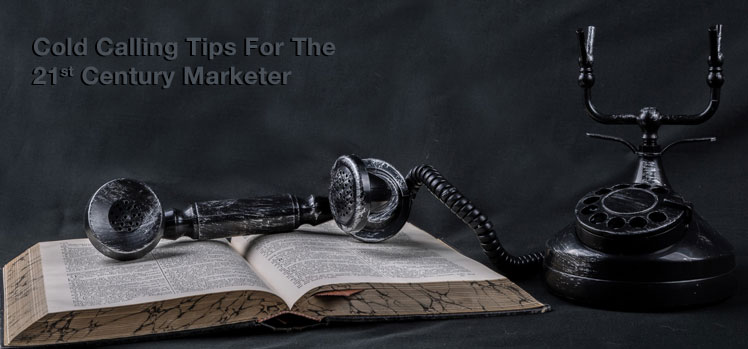Cold calling tips for the 21st century marketer
Well, of course calling up strangers to introduce them to your business, and subsequently try to sell them a couple of products is a difficult task. Probably even more challenging than making a move on your crush. It’s frightening to even the most experienced marketers- but then again, that’s precisely what makes it so enthralling.
To some people, cold calling is dead. They’d rather spend their precious time waiting for prospects to contact them, as opposed to initiating the entire process with complete strangers. Guess what? They are partially right, at least going by recent studies and authoritative report publications. According to the Keller Research Centre at Baylor University, for instance, only 1% of cold call leads are ultimately converted into customers. With an average call time of two minutes, it would take you close to three and a half hours of cold calling to secure one solid lead.
If your success rate is that low, you’re probably doing it like they did in the 90s. A lot has changed in the past two decades, and some of the biggest fortune 500 companies are embracing new cold calling strategies to effectively boost their results. So, if you’ll be engaging in cold calling in the 21st century, at least capitalize on new ideas that could potentially boost your success rate. Here is a couple of solid ones we’ve compiled:
Data is King
 Today’s virtual world is heavily reliant on data- and thankfully, there are loads of it. People are leaving data traces everywhere on the web. That’s why it’s pretty easy to profile them from their social media pages. You get to know about their preferences, interests and how they actually think just by scrolling through their page feeds. And that alone makes a huge difference between cold calling and blind prospecting.
Today’s virtual world is heavily reliant on data- and thankfully, there are loads of it. People are leaving data traces everywhere on the web. That’s why it’s pretty easy to profile them from their social media pages. You get to know about their preferences, interests and how they actually think just by scrolling through their page feeds. And that alone makes a huge difference between cold calling and blind prospecting.
Integrating data analysis into your cold calling process will help you identify and focus only on the target market. If you’re working in a B2B environment, for instance, this strategy should be key in identifying critical decision makers in every organization you contact. According to a survey conducted by the Gartner Group, only about seven people in typical companies with 100-500 employees are tasked with making most buying decisions. So you’ll be saving yourself the time and energy, which would otherwise have been spent on the other 493 employees, who wouldn’t fit the profile of an ideal prospect.
Call Only At The Ideal Times
Imagine getting a cold sales call when you’re stuck in traffic in the morning, feeling extremely groggy. Or right when you’re about to leave the office on a Friday evening.
 Well, of Cold callers, more often than not, get poor results because they fail to pay attention to simple, intricate details like timing. If you start off your work day at nine in the morning, you might want to give it some time before you pick up the phone to make cold calls. Going by Yesware’s analysis of over 25,000 sales calls, people clearly don’t like being bugged in the morning, or during weekends. Monday is also not a good time to make business pitches because it takes time to get over the weekend hangover and settle into the week. And sadly, this applies to Fridays too- we just can’t wait to get off work and get that weekend going.
Well, of Cold callers, more often than not, get poor results because they fail to pay attention to simple, intricate details like timing. If you start off your work day at nine in the morning, you might want to give it some time before you pick up the phone to make cold calls. Going by Yesware’s analysis of over 25,000 sales calls, people clearly don’t like being bugged in the morning, or during weekends. Monday is also not a good time to make business pitches because it takes time to get over the weekend hangover and settle into the week. And sadly, this applies to Fridays too- we just can’t wait to get off work and get that weekend going.
The best time to call up a prospect, according to the survey, is between 3.00-5.00pm on Tuesdays and Thursdays. Callers are particularly chatty at these times because the bulk of calls lasting over five minutes have been proven to occur then.
Capitalize on Special Events To Break The Ice
If you got in touch with someone right after they committed themselves to your competitor, chances are they won’t even listen to you for 60 seconds. Sorry, but that’s just how things work.
but that’s just how things work.
So, what do you do to win over new clients? Simple, keep tabs on their latest events. It may seem like a pretty complex undertaking at first, but thankfully there are services like Mention and Google Alerts that you could leverage. They will help you keep an eye out for opportune moments to make a move on a prospective customer, and consequently have your call received with much more enthusiasm.
Events like company expansions should be ideal to pitch in products and services for new hires and locations while dropping a line to say congratulations after a merger or large contract could help you get a foot in the door, and bring in a much-needed product. It’s a simple game, and extremely rewarding if you get your moves right.
Eliminate No From The Options
Well, here’s a word all marketers dread. If you don’t want to hear “No”, you have to finesse your way around the questions, and completely eliminate it as a possible answer. That way, whatever choice the respondent makes, you ultimately come out as a winner.
 Seems impossible, right? To put it into perspective, let’s look at a scenario explained by David Glass, a former stockbroker who inspired the Hollywood film “Boiler Room”. Instead of asking a potential client whether they’d like to get shares or not, he would go with something like “Many of our clients right now are doing 150 shares right now, but some are going for 2000. Which one do you prefer?” At the end of the day, even without closing a 2000 share sale, he’d still stand a fair chance of recruiting a 150 share client.
Seems impossible, right? To put it into perspective, let’s look at a scenario explained by David Glass, a former stockbroker who inspired the Hollywood film “Boiler Room”. Instead of asking a potential client whether they’d like to get shares or not, he would go with something like “Many of our clients right now are doing 150 shares right now, but some are going for 2000. Which one do you prefer?” At the end of the day, even without closing a 2000 share sale, he’d still stand a fair chance of recruiting a 150 share client.
These tips should help you get the ball rolling. Closing a sale, ultimately, is dependent on a plethora of other factors like interpersonal communication skills, preparedness, and knowledge of the subject matter. We sure would love to hear secrets that have worked for you. So feel free to drop a comment

1 Comment
Alizadeh
about 8 years agoI've always thought about cold calling as a last resolution and have never tried it... It's kind of risky and I think, will bother my customer. I've read your posts and though I enjoyed it, I still have some doubts about cold calling. Does it really work? How much? Should I use it as an active way to find customers and just let it stay at the end of my priority list? Thanks Again Alizadeh Ever247
Reply